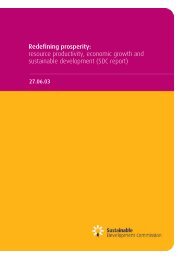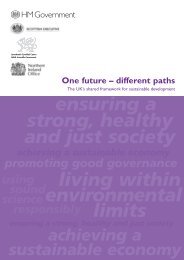Every Child's Future Matters - Sustainable Development Commission
Every Child's Future Matters - Sustainable Development Commission
Every Child's Future Matters - Sustainable Development Commission
Create successful ePaper yourself
Turn your PDF publications into a flip-book with our unique Google optimized e-Paper software.
The studies commissioned for this paper point to a range of actions that might be taken by government –<br />
central, regional and local – to develop the environmental dimension of children’s policy. Three areas are<br />
highlighted as priorities, not only because the evidence demands urgent attention, but because time and<br />
again children refer to them as particular causes of concern:<br />
Priority 1: Road traffic<br />
The benefits to society arising through greater<br />
personal mobility have been obtained at substantial<br />
(and often overlooked) costs to communities, and<br />
most particularly children who are no longer free<br />
to explore their local areas safely, and are most<br />
susceptible to traffic noise and pollution. This is a<br />
serious problem as it shrinks and degrades the space<br />
children grow up in, with implications for physical<br />
and mental health.<br />
Response 1a<br />
New developments and regeneration schemes<br />
should aim to reduce pollution, noise and safety<br />
problems arising from road traffic, not simply<br />
minimise further negative impacts – a very<br />
important distinction. Safe and healthy freedom<br />
of movement of children and young people (and<br />
everyone else) across communities should be<br />
a goal of existing and new local developments.<br />
This cannot be achieved, for example, by locating<br />
new houses next to busy roads (whether or not<br />
such areas happen to be available for development)<br />
or placing new roads and infrastructure close to<br />
residential areas. New developments need to be<br />
designed around pedestrians and cycle users with<br />
safer walking areas, enforcements to stop vehicles<br />
parking on pavements and ‘traffic-taming’ 20 mph<br />
zones.<br />
It should be possible for young people and<br />
parents to make sustainable journeys safely from<br />
their homes to schools and local services. Cycle lanes<br />
that are off-road or have low protection barriers<br />
between cyclists and traffic should be extensive<br />
as they are in some other European countries, and<br />
public transport should be intelligently designed<br />
and affordable. A density of 50 homes per hectare<br />
is vital to enable communities to attract and sustain<br />
good public transport and support a local school.<br />
High levels of density need not mean a drop in<br />
desirability or quality. Housing in some of the most<br />
expensive parts of London such as Kensington has<br />
grown to a density of 400 homes per hectare and<br />
remains extremely popular. 125<br />
<strong>Every</strong> Child’s <strong>Future</strong> <strong>Matters</strong> 39








